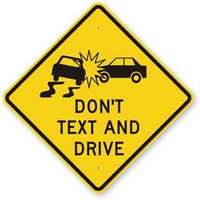Northwest drivers say they're free from distraction, but fear other drivers
 |
SEATTLE--Feb. 27, 2013: Driving from point A to B has never been so wrought with tempting driving distractions. From built-in navigation systems to the ubiquity of hand-held mobile phones, technology, among other age-old distractions, competes for driver attention on the road. But according to the latest poll from PEMCO Insurance, about two-thirds of Northwest drivers say they're rarely or never distracted behind the wheel.
The poll finds that 69 percent of Washington drivers and 63 percent of drivers in the Portland area say they're rarely distracted. More than four out of five drivers in both states say they don't engage in common distractions, like texting or talking on a cell phone, steering with their knees, or tending to personal grooming.
Still, that leaves about one in three drivers who do feel distracted while driving at least some of the time. Of those who admit to sometimes feeling distracted, one-third are drivers in Washington and Oregon under age 35. What's more troubling, nearly one-quarter of younger drivers don't think it's dangerous to drive distracted.
"The risk is two-fold here: younger drivers have the least driving experience and are already more likely to get in an accident. Adding distractions from technology and passengers, along with an attitude that it's not dangerous to drive distracted, is dangerous for them, their passengers, and other drivers," said Jon Osterberg, PEMCO Insurance spokesperson.
While drivers under age 35 account for about one-quarter of the population in the U.S., young drivers were involved in more than 40 percent of fatal crashes nationwide, according to a 2010 study by the National Highway Traffic Safety Administration (NHTSA). Car crashes are the leading cause of death for teenagers, according to NHTSA and the National Center for Health Statistics.
According to the PEMCO poll, about half of drivers of all ages say it's very dangerous for them to drive with distractions, and significantly more -- 78 percent -- think it's extremely dangerous for other drivers to be distracted.
The poll suggests that the most common driving distractions for all drivers include drinking beverages, chatting with passengers, retrieving items such as a CD or sunglasses, and eating food while driving. Across the board, younger Northwest drivers say they're more likely than older drivers to engage in these distractions.
Perhaps less surprising, having children also leads to a greater likelihood of feeling distracted behind the wheel. More than 40 percent of parents say they sometimes or often feel distracted, while almost three-quarters of drivers without children are never or rarely distracted, according to the poll.
"Though many think multi-tasking while driving is no big deal, any time you take your eyes off the road and your hands off the wheel, danger increases," Osterberg said. "It's particularly risky for those who drive manual transmissions to do things like eat food, tend to pets, hold a phone, put on makeup, or shave."
To learn more about the PEMCO Insurance Northwest Poll and to view a summary of the results, visit www.pemco.com/poll, where the public is invited to participate in an informal version of the poll and see how their own responses compare with those collected by FBK Research of Seattle in October 2012.
About the PEMCO Insurance Northwest Poll
PEMCO Insurance commissioned this independent survey that asked Washington and Oregon drivers several questions about driving
habits and attitudes toward current Northwest issues. The sample size, 609
respondents in Washington and 401
respondents in the Portland, Ore., metro
area, yields an accuracy of +/- 4.1 percent and +/- 5.0 percent
respectively at the 95 percent confidence level. In other words, if this
study were conducted 100 times, in 95 instances the data will not vary by
more than the associated error range.


